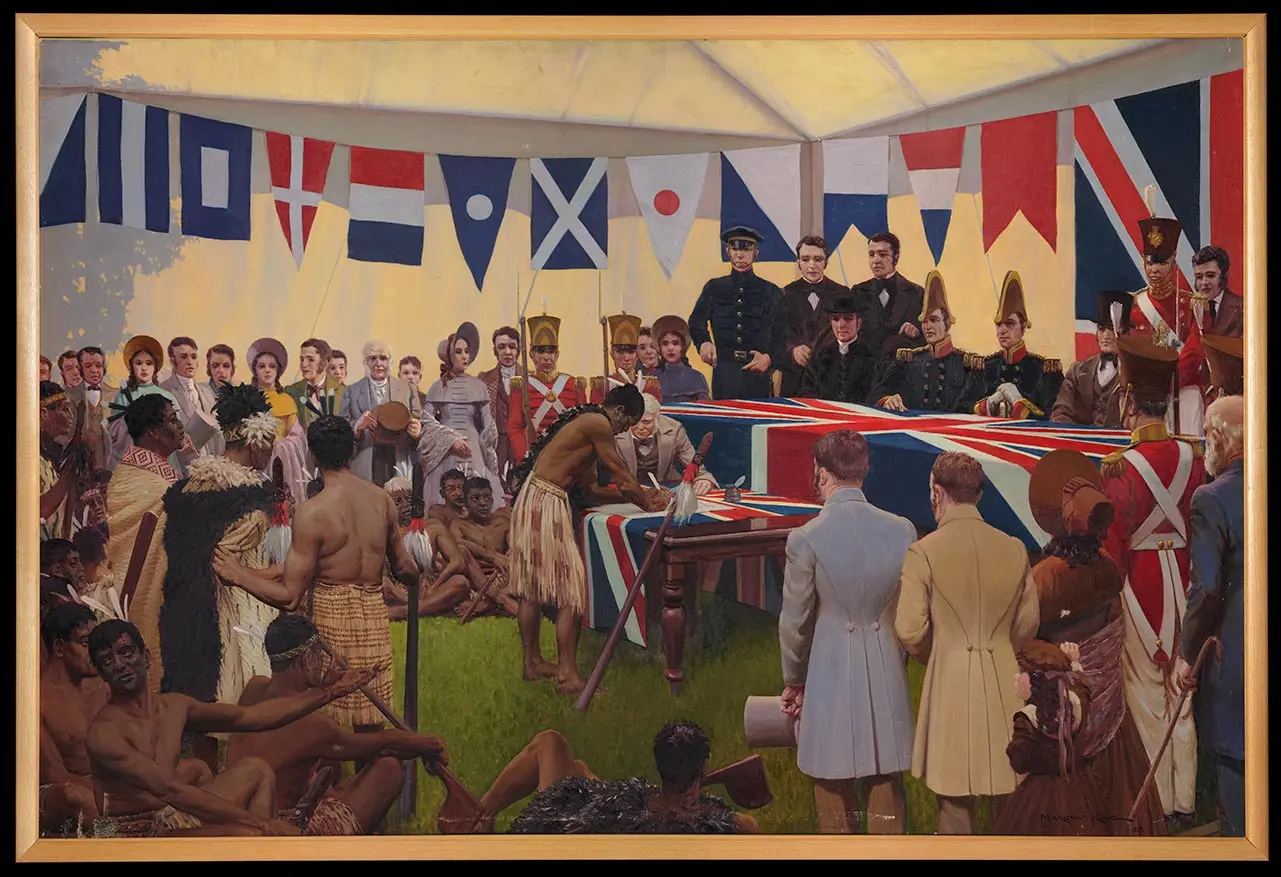Image credit: The Signing of the Treaty of Waitangi, February 6th, 1840, 1938 by Marcus King. Ref: G-821-2 Alexander Turnbull Library.

Image credit: The Signing of the Treaty of Waitangi, February 6th, 1840, 1938 by Marcus King. Ref: G-821-2 Alexander Turnbull Library.

Marcus King’s 1938 painting is an imagined version of the signing of the Treaty of Waitangi. Read about the painting and how it reflects some common beliefs of the time. Find out more, and explore our collections and curated resources.
Marcus King’s grand 1938 oil painting of the signing of the Treaty of Waitangi was a bold feature of New Zealand’s pavilion at the World’s Fair, held in 1940 in New York, where around 8 million people saw it. Coinciding with New Zealand’s centennial celebrations, the painting demonstrated how the government wished New Zealand to represent itself in terms of its Māori population — with ‘the best race relations in the world’.
The event’s depiction reflects a popular belief that the signing was an orderly and not obviously complicated process. Certainly, the work was intended to present the event in an idealised way. Indeed, the whole scene is imaginary; no one who witnessed the Treaty signing on 6 February 1840 is known to have made a picture of it. So, when government artist King (1891–1983) came to paint this image, he had little visual evidence on which to base his conception. As it turned out, many of the details are historically inaccurate.
Unlike Leonard Cornwall Mitchell’s 1949 depiction of the signing, King’s painting seems to have lacked a key that enabled viewers to identify the people shown. The caption to a print of the work published in the New Zealand Free Lance in 1939 simply gave a few names.
The rangatira seen signing the document was named as Ngāpuhi leader Tāmati Wāka Nene. Also present were the missionary Reverend Henry Williams, Captain Joseph Nias of the Royal Navy, the new Lieutenant Governor, Captain William Hobson, and James Busby, the former British Resident. It is difficult to be sure who is who.
The flags, evidently meant to represent signal flags used by naval and merchant shipping, do not conform to systems or codes used at the time. Some of the details of the naval costumes are also inaccurate.
King’s composition may be derived from the famous American painting The Treaty of Penn with the Indians, completed by Benjamin West in 1772. It shares many features of West’s composition, including the frieze-like row of figures and the gesturing indigenous figure in the foreground. King’s painting was passed to the Turnbull Library from the Ministry for Foreign Affairs and Trade in 1990.
In 1952, King completed an even larger version of the scene, somewhat different from the earlier composition, for exhibition in London. Unfortunately, it is not clear what happened to this version. In 2014, it was re-created from photographs by New Zealand artist Dick Frizzell.
Story written by: Oliver Stead
Copyright: Turnbull Endowment Trust
Marcus King had a long career as an artist, both privately and commercially. He worked for the Publicity Studios of the National Film Unit from 1930 to 1960.
Read a connected story from Te Kupenga: Another view of Waitangi.
Explore the Alexander Turnbull Library collections further:
Topic Explorer has:
Many Answers has Treaty of Waitangi.
Want to share, print or reuse one of our images? Read the guidelines for reusing Alexander Turnbull Library images.
Tikanga ā-iwi:
Te whakaritenga pāpori me te ahurea
Te ao hurihuri.
Te Takanga o Te Wā (ngā hītori o Aotearoa):
Whakapapa
Mana motuhake.
Social sciences concepts:
Identity, culture, and organisation
Continuity and change.
Aotearoa New Zealand’s histories:
Māori history is continuous
Colonisation and its consequences
The exercise of power
Relationships and connections between people.